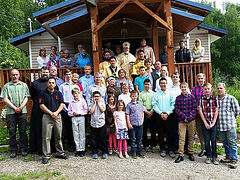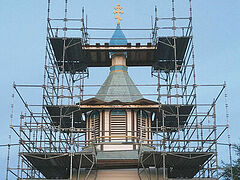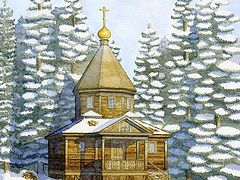Archbishop Gregory of Alaska and Sitka wasn’t one of the “high-profile” archpastors of the Russian exile community. Peaceful, simple-hearted, hardworking, and selfless man of faith, he was one of those who kept Russia and the Russian Church strong since time immemorial.
 Archbishop Gregory (Afonsky) of Alaska
Archbishop Gregory (Afonsky) of Alaska
Childhood years at Podol
Archbishop Gregory of Alaska and Sitka (secular name Georgiy Sergeevich Afonsky), was born on April 17, 1925, in Kiev. He came from a family of a long line of priests. The Very Rev. Mikhail Edlinsky (1859–1937), his maternal grandfather and father confessor to all the Kievan clergy, was a rector at the ancient Sts Boris and Gleb Church at Kiev’s Podol. Vladyka’s father, the Very Rev. Sergiy Afonsky, also served there. Vladyka Georgiy used to call this church “our church.” Vladyka also called the Kiev Pokrov monastery a “dear place… for our family.”
 Saints Boris and Gleb Church at Podol “It is the monastery where Fr. Pyotr Afonsky, our grandfather, served as a priest, where he died and was buried. Our father, Fr. Sergiy Afonsky, also served and later died there following his release from GULAG. This is where our mother stayed and passed away, as well.”
Saints Boris and Gleb Church at Podol “It is the monastery where Fr. Pyotr Afonsky, our grandfather, served as a priest, where he died and was buried. Our father, Fr. Sergiy Afonsky, also served and later died there following his release from GULAG. This is where our mother stayed and passed away, as well.”
In the 1930s, the Sts. Boris and Gleb Church was destroyed, grandfather Very Rev. Fr. Mikhail was arrested, and their family residence confiscated. In a flash, everyone became “disenfranchized,” and stripped of their civil rights. His Grace’s older siblings couldn’t continue their education beyond the seventh grade. During those tough times, their mother, Vera Mikhailovna, became a spiritual pillar to many Kievans. After her husband was sent away to the “Ussol” concentration camp in Solikamsk for “anti-revolutionary activity,” he became gravely ill there. Matushka left her six children in Kiev and traveled to the Northern Urals where she managed to save Fr. Sergiy from inescapable death by bringing him food and warm clothing.
Grandfather
 Protopresbyter Mikhail Edlinsky Protopresbyter Mikhail Edlinsky, Vladyka’s grandfather, had a great influence on him. What an extraordinary priest he was! Deeply devoted to serving God, he took to heart the misfortunes of others and was never afraid of anything. The downtrodden and the troubled flocked to see him from every corner of the city, and he helped everyone.
Protopresbyter Mikhail Edlinsky Protopresbyter Mikhail Edlinsky, Vladyka’s grandfather, had a great influence on him. What an extraordinary priest he was! Deeply devoted to serving God, he took to heart the misfortunes of others and was never afraid of anything. The downtrodden and the troubled flocked to see him from every corner of the city, and he helped everyone.
During the pogroms, he protected the Jews from vengeful crowds but he never condemned the attackers, explaining that they are uneducated and misled people. Righteous John of Kronstadt met him in 1893, and after their meeting, St. John used to tell the Kievans who flocked to him:
“Why do you come to see me? You have your very own God-pleasing man, my spiritual father and friend Fr. Mikhail Edlinsky!”
Priest Sergiy Sidorov recalled:
 Archpriest John of Kronstadt “Once, he prayed for a long time at church before the icon of Holy Hierarch Nicholas … and then he came up to me, embraced me, and said mournfully pointing to the icon of Christ: “He suffered terribly! Whenever you are in sorrows, remember Him.” “Batiushka,” I asked, “will I have to suffer?” “Yes, this coming autumn,” replied Fr. Mikhail. “But those who receive their crowns will be saved.”
Archpriest John of Kronstadt “Once, he prayed for a long time at church before the icon of Holy Hierarch Nicholas … and then he came up to me, embraced me, and said mournfully pointing to the icon of Christ: “He suffered terribly! Whenever you are in sorrows, remember Him.” “Batiushka,” I asked, “will I have to suffer?” “Yes, this coming autumn,” replied Fr. Mikhail. “But those who receive their crowns will be saved.”
In 1937, all the clergy of St. Nicholas on the Embankment Church, where Fr. Mikhail was serving after the destruction of the Sts. Boris and Gleb Church, were arrested following a deacon’s false denunciation. On the eve of the arrest, a man from the NKVD came to warn him and advise him to leave the city. To that, Fr. Mikhail answered: “Does one run away from the Cross?”
Archpriest Mikhail Edlinsky was arrested and executed a few months later at the age of 78. The place of his burial is unknown.
Forced labor in Germany. Priesthood and tonsure
Even after death, Vladyka’s grandfather prayerfully interceded for him. In 1942, the sixteen-year-old Georgiy was rounded up on the streets of Kiev and taken to Germany as a slave laborer. He was assigned to do hard menial jobs in Berlin. A Russian woman saved him from starvation. When she took him to her home, the first thing he saw on the wall was his grandfather’s portrait. It turned out she was a parishioner of the Sts. Boris and Gleb Church in Kiev.
While in Germany, Georgiy learned from a clipping from a Parisian newspaper that his uncle Nikolay Afonsky, a well-known musician of the Russian exile community, was about to perform in a concert.
Georgiy was able to get in touch with him, and in 1949, thanks to his uncle’s petition, he moved to the USA where he received degrees in music and theology in addition to a secular education. He served as a choir director at various parishes for about fifteen years. Following his graduation from the University of Connecticut and St. Vladimir’s Seminary, he was ordained a priest in 1965 and later, in 1971, tonsured with the name of Gregory.
On March 13, 1973, having already obtained his degrees from St. Vladimir’s Seminary and Hofstra University, Fr. Gregory was consecrated bishop of Sitka and All Alaska. He devoted twenty-three years of selfless service at the Church of Alaska, continuing the legacy of the enlightener and missionary, St. Innocent (Veniaminov, †1879).
Bishop Gregory and Alexander Solzhenitsyn
Alexander Solzhenitsyn (1918-2008) depicted Vladyka in his autobiographical sketches.1 In the spring of 1975, when the writer and his family ended up in exile, Bishop Gregory sent a letter to Alexander Isaievich thanking him and inviting him to visit Alaska:
“In 1970, while at the Hofstra University in the USA, I defended my master’s thesis on “The Timeless Issues in the Solzhenitsyn’s Novels.” Thank you, dear Alexander Isaievich, for my grandfather, papa, and other relatives who perished in the camps of the “Archipelago” with you as their only champion.”
In mysterious ways, the Lord brought me to Alaska, former Russian America, to serve as a spiritual guide for the heritage of our missionaries: Orthodox Aleuts, Eskimos, and Indians. We have decent archives; peaceful and truly remote places abound here, and all of this is at your disposal for work and recreation if you would honor us with a visit.”2
 Bishop Gregory and A.I. Solzhenitsyn in Alaska. 1975.
Bishop Gregory and A.I. Solzhenitsyn in Alaska. 1975.
The Solzhenitsyns traveled to Alaska in May of 1975. They felt an instant connection:
“Apart from Russia itself, there is no other such Russian place left… Sitka (New Arkhangelsk) greeted us in a purely Russian way, on top of having their own Russian bishop, Gregory Afonsky…
We stayed with Bishop Gregory as if we were back in Russia again; moreover we swam in hospitality. We attended the church where he serves. After the service, little Aleutian children cuddled up around him in a tight circle (as if we were somewhere in the Russian North) saying repeatedly: “Bisha-Grisha!” (affectionate name for “Bishop Gregory”)”.3
The friendly connection established between Bishop Gregory and Solzhenitsyn during that short trip remained and their interactions brought both of them joy, warmth, and consolation. In October 1977, Vladyka Gregory consecrated a chapel to St. Sergius of Radonezh at the Solzhenitsyn’s property grounds in Vermont, essential for them to serve the liturgy, pray, and bring up their children in the faith. Vladyka wrote:
“St. Sergius will always protect all of you just like he protected me during the most difficult times of my life in the German camps. My mother sent me particles of St. Sergius’s holy relics before her death.”4
In these godforsaken places, “people remain Orthodox, and it is pure miracle. I feel so sorry for them and how I wish I could help them!”
During his heroic years of archpastoral service in adverse climatic conditions, Vladyka visited all eighty-seven diocesan parishes. He taught at St. Herman’s Seminary in Kodiak, and rebuilt the burned-down St. Michael’s Cathedral in Sitka.
Vladyka Gregory left the following details about his missionary trips:
“My trip around Alaska was a success. I visited some villages that don’t see a bishop or a priest for two to three years. Yes, they still have such places here! It’s a true miracle that the people remain Orthodox. I feel so sorry for them; how I wish I could help them!”5
 Bishop Gregory at the Sitka Icon of the Mother of God
Bishop Gregory at the Sitka Icon of the Mother of God
 St. Michael’s Cathedral in Sitka
St. Michael’s Cathedral in Sitka
At the end of his life, Bishop Gregory thanked God:
“I am thankful to God that He gave me such a great field in Alaska to plant a new vineyard of the Lord. Its people, in particular are young, kind, and sincere parishioners. It was a gift from God. I wouldn’t want another lot.”
Return to Russia
In 1996, Archbishop Gregory visited Moscow and Kiev where he met with his brothers and sisters. In his memoirs (kept at the archives of the Orthodox Church of America in Syosset) Vladyka said that
his meeting with relatives, “a vigil before the relics of St. Sergius, the veneration of Alaska’s own St. Innocent whose relics rest at the Dormition Cathedral, were truly … a spiritual experience worth the fifty-for-year wait.”
It was especially moving for him to see Kiev again. Bishop Gregory was so intimately connected with this city! He came down from Moscow by train feeling overjoyed and fearful at the same time:
“I lived through the famine of 1932 and all its horrors, as well as the arrests—first of my grandfather in 1937 and then my father in 1938. I lived through the German occupation in September of 1941, the fires in the city, and the atrocities of Babi Yar6 all taking place at the same time. Yet, along with the tragic circumstances, there were the joyful moments of my youth: swimming at Trukhanov beach, playing in the string orchestra, my school friendships, soccer, music and literature, a memorial concert dedicated to the 100th anniversary of Pushkin’s death in 1937, family picnics at Puscha-Voditsa, or Kiev’s chestnut trees. It was as if good and bad fused together, so I was going to Kiev “fearfully rejoicing,” not knowing how the city would treat me this time…”
Vadyka’s impressions of his visit to Kiev follow below. Here are some excerpts (published for the first time with their original spelling [in Russian]):
“October 11-12. A first trip to the old town, the Dnieper and Podol. The pride of the Kievans, the subway, clean and neat (retirees travel for free!) delivered us in mere minutes to the place where a local landmark, the funicular tram, the joy of local children, begins its ascent. We walked along the embankment towards the Belozorenko residential building where we lived beginning from 1930. It stands in neglect, being currently used as a storage facility. I could be biased but I thought that our apartment’s windows were the exact color they were fifty-four years ago. We walked along Bratskaya Street past the former location of our Boris and Gleb Church. I call it “our” as it was where our grandfather served and I was an altar server from the age of five; this is where our whole family was baptized. I still remember how people wept when its bells were thrown down…
October 13-14. We served the Divine Liturgy at the Kiev Caves Lavra’s great refectory church, with Stolypin’s grave next to its entrance. It was a solemn service, a large gathering of the faithful was present with two choirs singing. It was hard to give a sermon for I was seized with feelings of unworthiness and fear before the host of all the founders of Orthodox Rus’ resting in that monastery. However, at the end of the sermon, I heard, “May the Lord save you!” in Russian for the first time from a great number of faithful.
October 17. We head to the monument of the Equal-to-the-Apostles St. Vladimir, whose cross has protected Kiev for over forty years from foreign invaders, civil strife, and political violence. How many times during our childhood years we would run around this magnificent monument! But here’s a new Kreschatik Street, the old one burned down before my eyes. The Dynamo Stadium, Tsarsky Garden, the Mariinsky Palace, the Covered Marketplace—everything as it was 54 years ago. What are my general impressions of the current life in Kiev? I will offer the following two episodes to my readers.
Number one is the women of all ages and walks of life silently and patiently standing along the stairs leading down to the Metro in an attempt to peddle some of their personal belongings. I felt uneasy taking their photos. They avoided raising their eyes, feeling ashamed of their poverty.
Picture number two is the Borschagovka area, one of Kiev’s suburbs where, as I was told, a “true local government“ resides. I see rows after rows of mansions with swimming pools, built-in elevators, surrounded by towers and fences. Every mansion costs no less than half a million US dollars. These residential homes were built within the last couple of years, not by some illicit traders but by the members of the city government and local management—in other words, the new elites. How could one fill in the abyss between these two pictures, these two ways of life in today’s Ukraine? I have no answer. One can only wish that, in the years to come, Ukraine would find in its midst intelligent and honest leaders who love and respect her people.”7
Bitterness about communism, which crippled the nation and its people, was mixed with feelings of joy and hope:
“My joy of being able to travel freely in the heart of Russia was overshadowed by feelings of bitterness and sorrow that this historical place once cradled the greatest evil and the worst militant atheism in the history of the world … The ‘triumphal song’ I delivered in Moscow’s Kremlin, the epicenter of Russia’s state and religious life, I accepted both in its mystical sense and in its real sense. Mystically, it was a song of triumph, on my behalf and of those of my family who died for the Orthodox faith over the decades-long evil war against God waged from inside the Kremlin.
In real sense, the ‘triumphal song” proclaimed the actual truth of Christ: I will build my church; and the gates of hell shall not prevail against it (Matthew 16:18). Just think of it: in 1940, the Communists talked about the annihilation of faith and the Church. Currently in Moscow alone there are 267 churches, monasteries, and chapels.”8
Vladyka passed away in 2008 at the age of 82 in Jackson, NJ. His memory is kept alive in the hearts of his many friends and spiritual children.
To be continued.
The author expresses gratitude to Alexey Liberovsky, the OCA Registrar, for providing the archival OCA documents and photos used in the article, and to Jeffrey McDonald for the photos and articles from his personal files.





